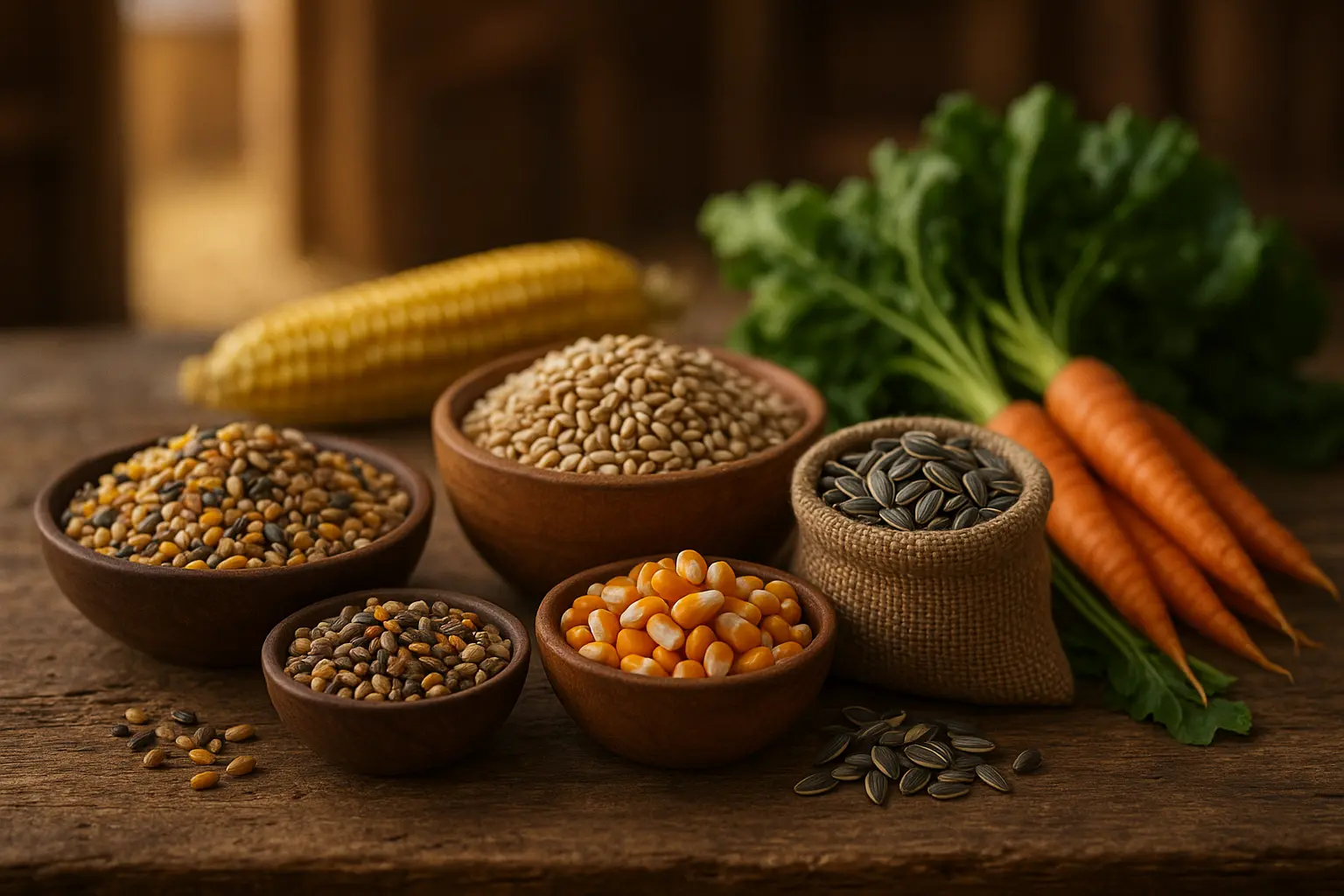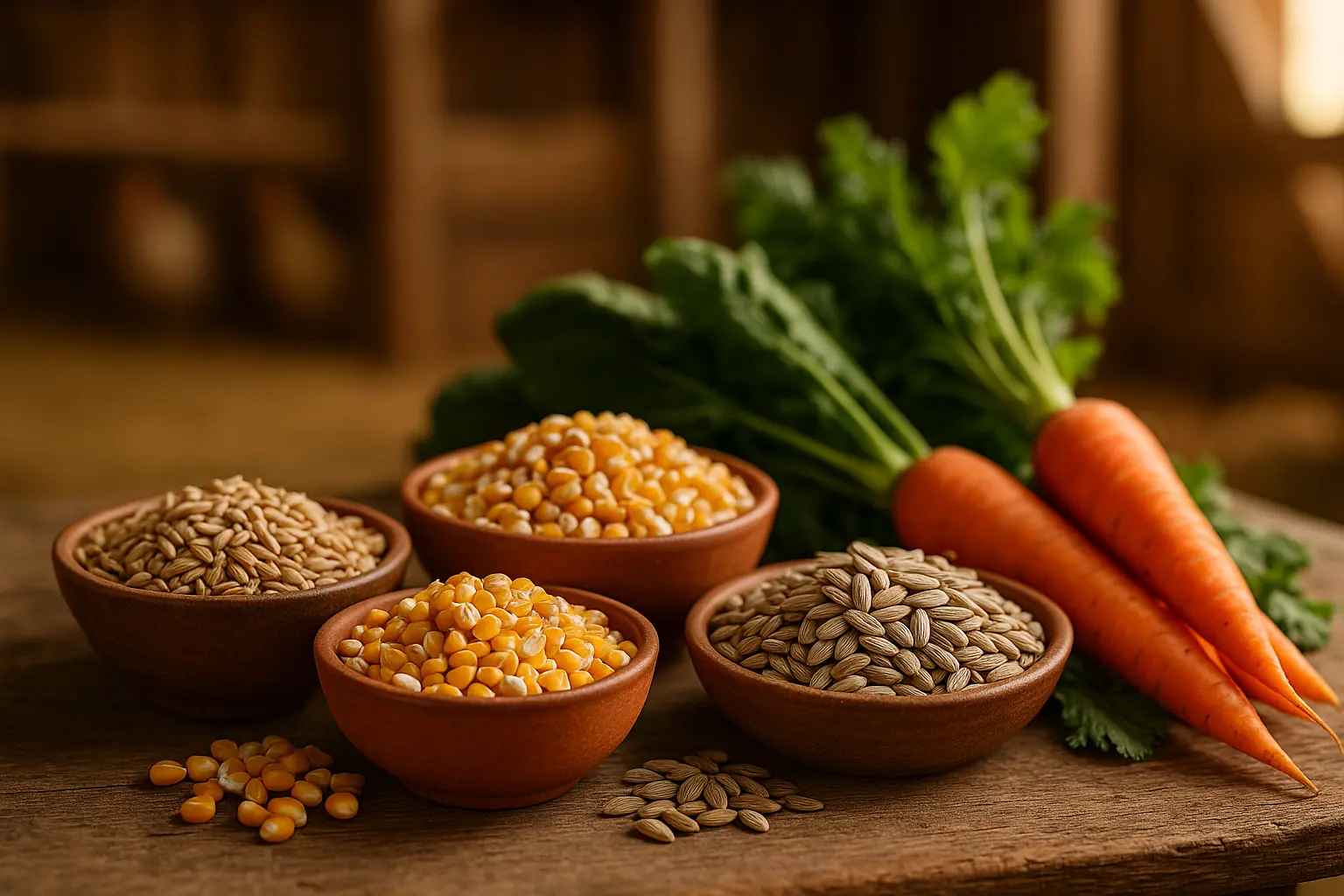In the dynamic world of poultry farming, crafting the perfect diet is akin to mastering a culinary art, where each ingredient plays a pivotal role in transforming your flock’s health and productivity. Whether you are an experienced farmer or a backyard poultry enthusiast, understanding the nuances of feeding can significantly impact your birds’ performance and overall well-being. As guardians of these feathered creatures, your choices in feed composition and preparation can determine the difference between average and exceptional production outcomes.
Why Diet Matters
A well-balanced diet isn’t just about filling your chickens’ bellies; it’s about ensuring optimal growth, egg production, and meat quality. As we delve into this comprehensive guide, you’ll discover how specific elements like protein and calcium influence your poultry’s health. From selecting the right ingredients for different life stages to devising homemade recipes, we aim to equip you with the knowledge to enhance your flock’s potential. So, fasten your seatbelts as we embark on this journey to superior poultry feeding!
The Art of Balancing Protein for Growth
Understanding Protein’s Role
Protein is the building block of life, and for poultry, it’s particularly crucial. Chickens, like all birds, require a steady intake of protein to support muscle growth, feather development, and egg production. While it might seem straightforward to feed them a generic feed, the reality is more nuanced. Depending on the age and purpose of your flock—be it layers, broilers, or dual-purpose birds—you must tailor the protein levels in their diet to foster optimal health and productivity.
Sourcing the Right Protein
When considering protein sources, think beyond the conventional. While commercial feeds often rely on soybean meal, incorporating alternative sources such as fish meal can boost both the nutritional content and the taste appeal of the feed. Fish meal offers a rich source of essential amino acids, crucial for young chicks and growing broilers.
Recipe for Success
For a more sustainable approach, consider mixing your feed. A simple, balanced homemade recipe might include:
- 50% corn or wheat (for energy)
- 20% soybean meal or fish meal (for protein)
- 10% oats or barley (for fiber)
- 10% alfalfa meal (for vitamins)
- 5% ground limestone (for calcium)
- 5% supplemental minerals and vitamins.
This blend not only provides the necessary nutrients but also allows for custom adjustments based on your specific flock needs. Remember, a varied diet keeps your chickens happy and healthy, ultimately enhancing their performance in egg-laying and meat production.
The Role of Calcium in Egg Production
Calcium: The Eggshell Architect
Calcium is unequivocally vital for laying hens. Their need for this mineral is higher than any other poultry category, given its direct role in forming strong, resilient eggshells. Imagine the disappointment of discovering soft or malformed eggs in the nesting boxes—this is often a telltale sign of insufficient calcium in the diet.
Sources of Calcium
For optimal calcium intake, you can introduce crushed oyster shells or limestone into their diet. These supplements ensure your hens receive the necessary calcium without altering the primary feed’s taste or texture.
Beyond Eggshells: Comprehensive Benefits
Calcium also plays a role in blood coagulation and muscle function. Insufficient calcium can lead to health complications beyond poor eggshell quality, affecting the bird’s overall performance and wellbeing, such as weak bones and reduced mobility.
Practical Tips for Calcium Supplementation
- Separate Grit and Calcium: Offer crushed oyster shells in a separate feeder to ensure hens can self-regulate their intake.
- Monitor Egg Quality: Regularly inspect the eggshells for consistency and strength as a gauge of your calcium supplementation’s success.
- Life Stage Considerations: Recognize that calcium needs may vary according to the bird’s age and laying cycle, adjusting supplements accordingly.
In summary, by prioritizing calcium in your hens’ diet, you not only enhance their egg production capabilities but also safeguard their long-term health.

Innovative Diet Strategies for Enhanced Performance
Rethinking Traditional Approaches
In an era where sustainable farming practices are in vogue, traditional feeding methods are undergoing significant innovation. You might wonder how altering your chickens’ diet can yield tangible improvements in their performance and health.
Incorporating Natural Ingredients
Consider supplementing your poultry feed with fresh herbs like oregano, garlic, or thyme. These natural additives have shown potential in promoting digestive health and bolstering the immune system.
Embracing Seasonal Variations
Aligning your feed strategy with seasonal changes can optimize the nutritional intake. For instance, during colder months, increasing energy-dense grains like corn can help maintain body heat and energy levels.
The Power of Probiotics
Introducing probiotics into your chickens’ daily diet can enhance their gut health, leading to more efficient nutrient absorption and improved overall growth. This microbiome boost can positively affect their meat quality and egg production.
Recipe for a Probiotic-Rich Feed
To incorporate probiotics, consider adding fermented grains like barley or oats to their feed. This simple addition can result in:
- Improved digestion and nutrient uptake.
- Reduced risk of digestive disorders.
- Enhanced immune response.
By stepping out of the traditional feeding box and embracing modern, innovative strategies, you can significantly elevate your chickens’ performance and health.
Homemade vs. Commercial Feeds: A Comparative Insight
Weighing the Options
When it comes to feeding your poultry, the choice between homemade and commercial feeds can appear daunting. Each has its advantages and challenges, and understanding these can guide your decision-making process.
The Case for Commercial Feeds
Commercial feeds are designed with precision, ensuring a balanced combination of nutrients. They offer convenience and consistency, especially for large-scale operations. However, they may lack the flexibility required to cater to specific dietary needs or preferences.
Advantages of Homemade Feeds
Creating your chicken feed allows for customization. You can adjust the ingredients based on growth stages, specific health concerns, or even cost constraints. Homemade feeds also enable you to incorporate organic or locally sourced ingredients, promoting sustainability.
Crafting a Balanced Homemade Feed
Your homemade feed should aim to balance protein, vitamins, and minerals while being palatable for your chickens. A basic recipe might include:
- Energy sources: cracked corn, barley, or sorghum.
- Protein sources: fish meal, soybean meal, or peas.
- Supplements: calcium (crushed shells), vitamins, and minerals.
Making the Choice
Ultimately, the decision hinges on your specific circumstances, such as the size of your operation, available resources, and personal preferences. By weighing the pros and cons, you can opt for a feeding strategy that aligns with your goals, ensuring a thriving flock.
As we wrap up this journey through the intricacies of poultry feeding, it’s clear that the choices you make today can significantly impact your flock’s future. Optimizing diets isn’t just about meeting basic nutritional needs; it’s about understanding your chickens’ unique requirements and proactively addressing them through thoughtful feeding strategies.
Incorporating a blend of innovative techniques and time-tested practices, you can craft a diet that promotes healthy growth, robust egg production, and superior meat quality. Remember, every ingredient you choose is a stepping stone toward achieving your ultimate goal—a happy, healthy, and productive poultry farm.
By continuously evaluating and adapting your feeding regimen, you’re setting the stage for sustained success and a flourishing flock. So go ahead, feed your way to excellence!
FAQ
What are the key ingredients for a balanced poultry feed?
A balanced poultry feed should include a mix of grains, proteins, vitamins, and minerals. Common ingredients include corn, soybeans, wheat, fish meal, and necessary vitamins like A, D, and E.
How can I ensure the feed meets my poultry’s nutritional needs?
It’s crucial to tailor the feed based on the age and purpose of your poultry. Chicks need higher protein, while laying hens require more calcium. Regularly consulting nutritional guidelines can help maintain the right balance.
Are there natural additives that can enhance poultry feed efficiency?
Yes, you can include additives like garlic, ginger, and turmeric. These not only improve digestion and immunity but also enhance the overall health of the poultry.
How often should I change the feed composition for my poultry?
Feed composition should be adjusted according to the poultry’s life stage. Typically, changes are made when birds transition from chicks to growers and then to layers or broilers. Regular assessment of their health and production rates can guide these adjustments.
What are some cost-effective strategies for producing homemade poultry feed?
To cut costs, consider using locally sourced grains and by-products like rice bran or corn husks. Bulk buying and seasonal adjustments can also help in reducing expenses while maintaining feed quality.

